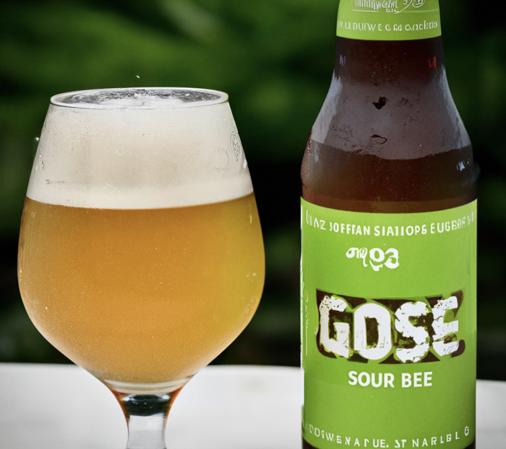Gose beers have been gaining popularity in recent years, as more and more craft beer enthusiasts are discovering their unique and refreshing flavor profiles.
As a brewer, I’ve had the pleasure of experimenting with different ingredients and techniques to create some truly exceptional Gose beers. One question that often comes up, both from fellow brewers and beer drinkers alike, is “how long do Gose beers last?”.
Gose beers generally last for about six months to a year, depending on storage conditions and whether the beer has been pasteurized or not.
In this blog post, I’ll dive deep into the world of Gose beers and explore their shelf life, the factors that contribute to it, and how to properly store them to ensure the best possible drinking experience.
Do gose sour beers get better with age?
It depends on the specific sour beer and how it was brewed. Some sour beers, such as lambics and Flanders red ales, can improve with age as the flavors become more complex and nuanced.

Gose sour beers are typically known for their bright, tart, and refreshing flavor profile, which is achieved through a process of kettle-souring with lactobacillus bacteria and the addition of salt and coriander.
Generally speaking, gose beers are not typically intended to be aged for long periods of time, as their flavor profile is best enjoyed when they are young and fresh.
That being said, there are some gose beers that may benefit from some aging. For example, if a gose beer has been aged in oak barrels, it may develop some additional complexity and depth of flavor over time.
Additionally, some brewers may intentionally create a sour beer with a higher starting gravity and more residual sugars to allow for a slower and more complex aging process.
However, it’s important to note that not all gose beers will benefit from aging, and some may actually lose their intended flavor profile and become less enjoyable over time. If you’re unsure whether a particular gose beer is suitable for aging, it’s always a good idea to check with the brewer or consult with a knowledgeable beer expert before storing it for an extended period of time.
1. The Basics of Gose Beer
Before we dive into the shelf life of Gose beers, let’s first discuss what sets them apart from other styles. Gose is a traditional German beer style that is characterized by its sour, salty, and slightly fruity flavor profile. It is brewed with a large portion of malted wheat, which contributes to its hazy appearance and smooth mouthfeel. The sourness in Gose beers comes from the use of lactic acid bacteria during fermentation, and the addition of coriander and salt adds even more depth to the flavor.
2. Factors that Affect the Shelf Life of Gose Beers
There are several factors that can impact the shelf life of a Gose beer, including:
- Pasteurization: Some breweries choose to pasteurize their Gose beers, which can help extend their shelf life by killing off any residual bacteria or yeast. Unpasteurized Gose beers typically have a shorter shelf life than their pasteurized counterparts.
- Oxygen exposure: Exposure to oxygen can cause off-flavors and aromas to develop in beer over time, and Gose beers are no exception. Minimizing oxygen exposure during packaging and storage can help extend the shelf life of a Gose beer.
- Storage conditions: Gose beers, like most other beer styles, should be stored in a cool, dark place to help preserve their flavor and freshness. Extreme temperature fluctuations and exposure to light can both have negative effects on the shelf life of a Gose beer.
- Bottle or can conditioning: Some Gose beers are bottle or can conditioned, meaning that they contain live yeast and continue to ferment and mature in the package. These beers can have a longer shelf life than their non-conditioned counterparts, as the yeast can help consume some of the oxygen in the package and improve the beer’s flavor over time.
3. Proper Storage of Gose Beers
To ensure that your Gose beers last as long as possible and maintain their optimal flavor, follow these storage guidelines:
1. Keep your Gose beers in a cool, dark place, ideally between 50-55°F (10-13°C). Avoid storing them in areas with direct sunlight or temperature fluctuations, such as near a window or in a garage.
2. Store Gose beers in an upright position to minimize the surface area exposed to oxygen and reduce the risk of leakage or damage to the packaging.
3. If you have a large collection of Gose beers, consider investing in a dedicated beer fridge or cellar to help maintain a consistent storage temperature and protect your beers from light exposure.
4. Keep an eye on the “best by” or “bottled on” dates on your Gose beers, and try to consume them within the recommended time frame to enjoy them at their freshest.
5. If you’re aging a bottle or can conditioned Gose beer, be patient and allow the beer to mature and develop new flavors over time. Just be sure to monitor the beer’s condition and consume it before any off-flavors or aromas become too pronounced.
4. Signs that Your Gose Beer Has Gone Bad
While Gose beers can last for several months or even up to a year, there are some telltale signs that the beer has gone bad or is past its prime:
1. Off-flavors or aromas: If your Gose beer has developed off-flavors or aromas, such as a cardboard-like, vinegar, or metallic taste/smell, it may be past its prime.
2. Changes in appearance: If your Gose beer has become excessively hazy, developed sediment, or changed color, this may be an indication that the beer has gone bad.
3. Flat or gushing beer: If your Gose beer is completely flat or gushes out of the bottle or can upon opening, this may be a sign that the beer has been improperly stored or is past its shelf life.
5. The Benefits of Fresh Gose Beers
When enjoyed fresh, Gose beers offer a plethora of unique and enticing flavors and aromas. Here are a few reasons why you should prioritize consuming your Gose beers while they’re still fresh:
1. Vibrant flavors: Fresh Gose beers showcase the perfect balance of sour, salty, and fruity flavors, making them incredibly refreshing and enjoyable to drink.
2. Aromatic complexity: The combination of lactic acid bacteria, coriander, and salt in fresh Gose beers creates a unique aromatic profile that can become muted or altered over time.
3. Smooth mouthfeel: The high wheat content in Gose beers contributes to their smooth and silky mouthfeel, which can be negatively impacted if the beer goes bad or is stored improperly.
6. Experimenting with Aged Gose Beers
While it’s generally recommended to consume Gose beers while they’re fresh, some beer enthusiasts enjoy experimenting with aged Gose beers to see how their flavor profiles change over time. If you’re interested in aging your Gose beers, here are a few tips to keep in mind:
1. Choose bottle or can conditioned Gose beers, as the live yeast can help improve the beer’s flavor over time.
2. Store your Gose beers in optimal conditions, as outlined in the storage techniques section above.
3. Monitor your Gose beers regularly and be prepared to consume them if you notice any signs of spoilage or off-flavors.
7. Pairing Gose Beers with Food
Gose beers are incredibly versatile when it comes to food pairings, and their unique flavor profiles can complement and enhance a wide range of dishes. Here are a few pairing suggestions to try with your Gose beers:
1. Seafood: The salty and citrusy notes in Gose beers make them an excellent match for seafood dishes, such as ceviche, shrimp, and oysters.
2. Salads: A crisp and refreshing Gose beer can help cut through the richness of a salad with creamy dressings or avocado.
3. Spicy foods: The sour and salty flavors in Gose beers can help tame the heat of spicy dishes like Thai or Indian curries.
4. Cheese: Gose beers pair well with a variety of cheeses, particularly tangy, creamy options like goat cheese or feta.
8. The Revival of Gose Beers
Gose beers have experienced a resurgence in popularity in recent years, as craft beer drinkers seek out new and exciting flavors. Gose beers offer a unique and refreshing alternative to more traditional beer styles, and their growing popularity has inspired brewers to experiment with a wide range of ingredients and brewing techniques.
9. Exploring Gose Beers from Around the World
While Gose beers have their roots in Germany, brewers from around the world have embraced this distinctive style and put their own unique spin on it. From American craft breweries to Belgian lambic producers, Gose beers can be found in a variety of interpretations and flavor profiles.
As a beer enthusiast, I encourage you to explore the diverse world of Gose beers and discover the many delicious options available.
Conclusion
In conclusion, Gose beers generally last for about six months to a year, depending on storage conditions and whether the beer has been pasteurized or not.
To ensure the best possible drinking experience, it’s important to store your Gose beers in a cool, dark place and consume them within their recommended shelf life.
Gose beers offer a unique and refreshing flavor profile that is best enjoyed fresh, but some beer enthusiasts may enjoy experimenting with aging and pairing Gose beers with various foods.
As a brewer and beer lover, I encourage you to explore the world of Gose beers and discover the wide range of flavors and aromas they have to offer.
FAQs
Do sour beers go bad?
Sour beers can go bad if they are not stored properly or if they are past their expiration date. The sourness in these beers is created by bacteria and wild yeasts, which can continue to ferment and change the flavor profile over time. It’s important to store sour beers in a cool, dark place and to check the expiration date before consuming.
Do sour beers need to be refrigerated?
Yes, sour beers should be refrigerated to maintain their flavor and prevent spoilage. The low pH and high acidity of sour beers can cause them to spoil quickly if not stored properly. Refrigeration helps to slow down the growth of bacteria and yeast that can cause off-flavors and aromas. It is recommended to store sour beers at a temperature between 38-45°F (3-7°C) to ensure the best quality and taste.
What temperature should sour beer be?
Sour beer should be served at a temperature between 45-55°F (7-13°C) to fully appreciate its flavors and aromas.
Are gose and sour beers the same?
No, gose and sour beers are not the same. Gose is a specific style of beer that originated in Germany and is brewed with salt and coriander, while sour beers encompass a broader category of beers that have a sour or tart flavor profile, which can be achieved through various brewing techniques such as using certain yeast strains or adding fruit.




